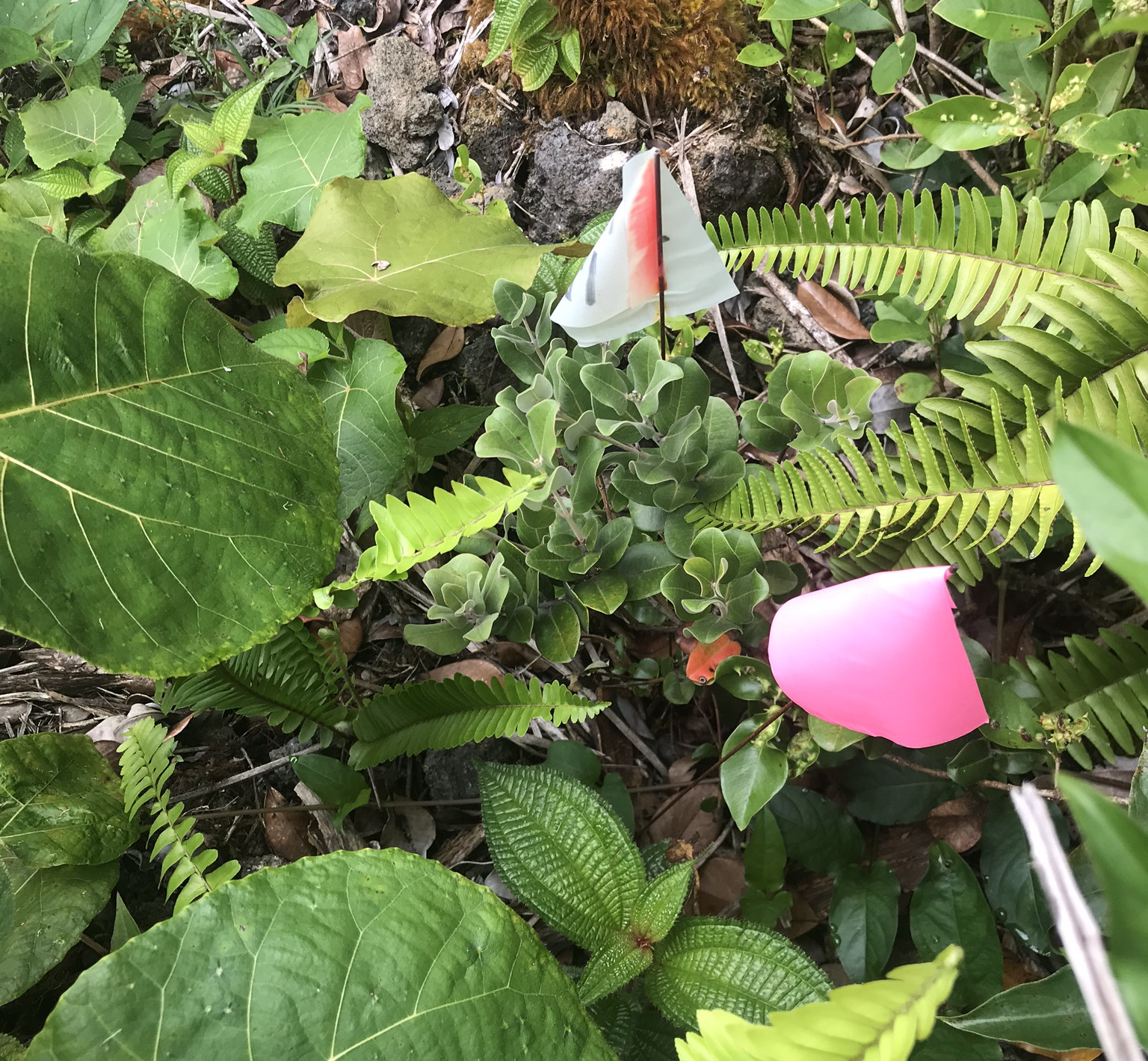
ʻŌhiʻa (Metrosideros polymorpha) seedling in an unweeded plot.
(Photo by Stephanie Yelenik, Pacific Island Ecosystem Research Center.)
(BIVN) – Natural ʻōhiʻa regeneration in forests infected by Rapid ʻŌhiʻa Death may be possible, scientists say.
The following news release was issued by the U.S. Geological Survey:
For the first time, researchers have shown that native ʻōhiʻa seedlings can survive for at least a year in areas that have active mortality from Rapid ʻŌhiʻa Death, or ROD, a fungal disease that is devastating to this dominant and culturally important tree in Hawaiian forests. This information can be useful to land managers and homeowners as they prioritize conservation actions.
The study, published recently in Restoration Ecology, was authored by scientists from the U.S. Geological Survey and Hawaiʻi Cooperative Studies Unit at University of Hawaiʻi Hilo.
“ʻŌhiʻa is a keystone species in Hawaiian forests, and ROD has the potential to cause major ecosystem disturbances that will negatively impact water supply, cultural traditions, natural resources and quality of life,” said USGS Director Jim Reilly. “This innovative research provides a glimmer of hope for native ʻōhiʻa tree restoration in Hawaiʻi by indicating that successful planting of ʻōhiʻa could be possible in ROD-affected forests if the native species’ seedlings are protected.”
The study also highlights specific best practices for maximizing seedling survival, noted Stephanie Yelenik, an ecologist with the USGS and lead author of the study.
“We found that ʻōhiʻa seedlings planted into a forest heavily affected by ROD have a high probability of survival for the first year,” said Yelenik. “While that one-year survival of seedlings is great news, this species lives centuries and there’s currently no treatment once the tree becomes infected. Because ʻōhiʻa grow slowly, a dead tree is a gap in the canopy for a long time, and one of Hawai‘i’s many quick-growing invaders can take over the gaps caused by dead trees.”
Still, she added, “these results provide the first, but still early, evidence that planting ʻōhiʻa may be used as a restoration tool in forests that are threatened by ROD.
ROD is a newly emerging disease caused by fungal pathogens. Since the disease was first discovered, ROD has killed at least 1 million ʻōhiʻa — a tree that is foundational to the Hawaiian landscape and culture. Its loss, study authors emphasized, is detrimental to habitat for endangered birds and plants, ecosystem processes and the cultural heritage of Hawaiians. There remains no treatment for infected trees, so slowing the spread of ROD remains important to protect native Hawaiian forests.
“The ʻōhiʻa tree is the dominant tree in Hawaiian forests, the first to colonize new lava flows and often forms the bulk of what makes up the forests,” said Yelenik. “While planting ʻōhiʻa may not be necessary in forests where ʻōhiʻa seedlings naturally occur, we thought planting might be a good tool for managers who want to maintain a native ʻōhiʻa canopy in forests dominated by invasive plants in the understory. We wanted to test that idea.”
To test how ʻōhiʻa seedlings would fare in areas where ROD is prevalent, researchers planted seedlings directly underneath adult ʻōhiʻa that had tested positive for Ceratocystis huliohia or lukuohia, the fungal pathogens that cause ROD. They monitored survival in plots that were fenced to keep animals out and removed seedlings of invasive trees and shrubs; other seedlings were planted in areas with no fencing or weeding. Seedlings that died were brought back to the lab for testing. In the lab researchers were able to test all the seedlings for the DNA of Ceratocystis and tested for evidence of viable fungal spores.
The results were clear: none of the dead seedlings tested positive for Ceratocystis, indicating that ʻōhiʻa can survive in ROD-affected forests if protected from wild pigs and goats and invasive trees and shrubs. In addition, seedlings were six times more likely to die in plots where weeds were allowed to grow than in areas where weeds were cleared around the ʻōhiʻa seedlings. In terms of prioritizing management, this means that controlling invasive plants and animals has a greater impact on survival in the tree’s first year than does exposure to ROD.
“The current study provides clues about the epidemiology of the disease and the dynamics of ROD pathogens across the landscape,” said Lisa Keith, research plant pathologist for the USDA Agricultural Research Service. “This information can help to slow the spread of the disease through effective management strategies. While surrounding disease pressure may be high, results suggest that ʻōhiʻa seedlings have the capacity to thrive in areas devastated by ROD.”
Results of the study indicated that ʻōhiʻa seedlings are not infected with ROD through the soil. “Those results are encouraging for two reasons,” said J.B. Friday, extension forester with the University of Hawai‘i Cooperative Extension Unit. “First, it means that even in forests with invasive trees and shrubs, ʻōhiʻa may possibly be re-established. And second, it means that in our high-elevation, pristine native forests, natural ʻōhiʻa regeneration could be possible, even in forests hit by ROD, if those areas are protected.”
Yelenik cautioned that longer-term studies of ʻōhiʻa seedling survival in ROD-affected forests are still needed, but these early results demonstrate that active planting could successfully help maintain native ʻōhiʻa forests. Survival of ʻōhiʻa seedlings in ROD-affected forests is good news, but the author noted that “protecting ʻōhiʻa from infection remains the primary tool in the fight against ROD.”


by Big Island Video News11:46 pm
on at
STORY SUMMARY
HILO, Hawaiʻi - Scientists have found that native ʻōhiʻa seedlings can survive for at least a year in areas that have active mortality from Rapid ʻŌhiʻa Death.